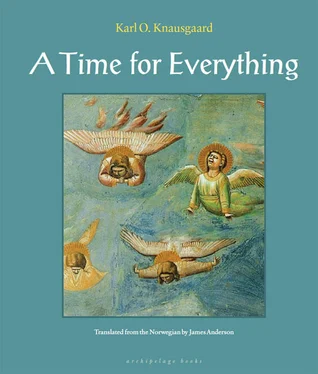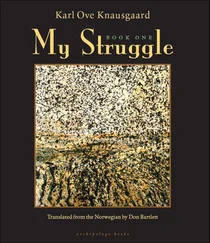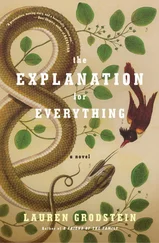A modern reader of the Bible is struck by how strong the connection between this world and the next once was. It can almost seem as if God was genuinely concerned about mankind. It took very little to get him to show himself and talk to men, or send one of his angels down to Earth to do his bidding. But these constant interventions never led to any permanent improvement. On the contrary, everything always reverted to its old ways. It seems as if all goodness and justness is the result of gargantuan efforts, which must constantly be repeated, in a continual maintenance that no human being is strong enough to manage. Even Lot, the angels’ unlikely favorite, succumbed in the end. After fleeing from Sodom, he settled in the mountains above Zoar with his two daughters. Still too fearful to chance living in the city, they dwelled in a cave, and there he got both of them pregnant. True, they were living alone in the mountains after an apocalyptic event, and may have been bewildered enough to believe that they were the last people on earth, and certainly the insemination took place at the instigation of the daughters, who plied him with wine before going to bed with him, but Lot must still have been well aware of the mark he was overstepping. He wanted his daughters, and he had them. For lustful thoughts may form such a tangled web above the sky of consciousness that not a single ray of light can penetrate to the soul, whose damp and dingy seat excludes all life-forms except the very lowest; moss and fungus, beetles and maggots, and a slimy snail or two blindly creeping about the mire. And who can be expected to do right under such conditions? For a time, perhaps, you’ll manage to keep it open a chink; righteous and enlightened as you still are, but sooner or later you’ll sleep, and when you awaken, you’ll be surrounded by darkness once again. If you have the strength, you’ll fight on, if you haven’t, you’ll give up. The human soul is a clearing in a forest, and for the divinely pure and untarnished it must be impossible to understand why it’s forever getting choked with growth. This is the struggle the Bible speaks of; the darkness that descends again and again on person after person, generation after generation, century after century, until the despair is unendurable, and the story ends in the description of the insane, apocalyptic fury that was revealed to John on Patmos: So the four angels were released, who had been held ready for the hour, the day, the month, and the year, to kill a third of mankind. They decapitate, burn, become a living torture, and from the bottomless pit they release swarms of poisonous locust-scorpions, which harm no grass or bush or tree, but only the people who haven’t the seal of God on their foreheads. Stars fall down to earth, the sun is darkened, forests burn in great firestorms, the seas turn to blood. A huge army is sent out numbering twice ten thousand times ten thousand, and they must have been an impressive sight for John, riding on horses with lions’ heads and clad in breastplates the color of fire and sapphire and sulfur. His descriptions are so detailed that there is no reason to doubt that he has seen what he’s describing, and yet there is something that grates, because since his vision in that cave on Patmos, things have happened to make the scenario he described impossible. The world will be destroyed, but not in that way. The angels have lost all the power they once had, and if they went to war with us now, we wouldn’t find it hard to crush them. At that time they probably did have plans to destroy everything, and it might have happened, too, if something hadn’t gone terribly wrong for them, so there is no need to lambaste John; he acted in good faith, and the fury he witnessed was at least authentic.
What the angels didn’t foresee was what a success Christianity would turn out to be. At the time they revealed the apocalypse to John, Christianity was still just a small, insignificant minority religion, something like our UFO sects, and as Christians were greeted with universal suspicion, and then persecuted, tortured, and killed, no one expected them to survive. When Christianity suddenly began to spread across the world in the first centuries after the death of Christ, the angels were completely unprepared. Soul after soul in country after country was saved. And all of them extolled the angels. Poetry was written about them, pictures were painted, theses written, stories told. By the time we get to the Middle Ages, angels were part of the common consciousness. They caused conditions resembling hysteria when they revealed themselves, because their proximity proclaimed those who’d been selected to carry out God’s will, perhaps to give away their wealth and dedicate their lives to the poor, as in the case of Francis of Assisi, or lead the French army into battle against the English like Joan of Arc, or just flog themselves until the blood ran as the many flagellants did. Bodies were racked with convulsions, fell into deep trances, spoke in strange tongues, exhibited sudden wounds. The angels themselves stood aloof from this monstrous physicalization of God’s word, but must have been fascinated by the way their mere presence could induce a phenomenon that was so utterly foreign to them. Fair, beautiful, and pure as they were, they must have felt a growing intoxication about the adoration they received. In any case they appeared more and more often, and gradually became the objects of another, and no less intense, kind of worship, in the welter of learned tracts and theses about angels that were written in the medieval period, tabulating, systematizing, and classifying all their various manifest forms in a kind of angelic taxonomy, complete with kinships, species, and subspecies. The Swedish theologian Lönnroth from Uppsala distinguished, for example, between material and immaterial, visible and invisible, immutable and mutable, with and without free will; in his On the Heavenly and Ecclesiastical Hierarchies , Pseudo-Dionysius the Areopagite argued that there were nine classes of angel, while Gregorius Tholosanus believed that the number was seven, in keeping with the seven planets, and that the virtuous could be found above the moon and the evil beneath it. Johannes Durandus discussed whether angels had memory, or if their consciousness occupied an eternal present. Were they pure form ( creatura rationalis et spiritualis )? Or were they, like human beings, both form and substance ( creatura corporalis et rationalis )? Bodine and David Crusius maintained in Theatrum naturae and Hermetica philosophia , respectively, that they were fully and entirely corporeal. Bodine put forward the odd notion that they must be as round as balls, because this is the most perfect of all shapes, while Bochard went as far as to claim that they were actually mortal, took sustenance, and had bowel movements.
In truth, the Middle Ages were the time of the angels. Can we blame them for allowing themselves to be flattered by this concerted attention? For being more and more often in the proximity of human beings, even when they had no specific business to perform there? They still radiated dignity with their stern looks, simple robes, and angular movements; their beauty still had something hard and cruel about it, not of savagery, but the opposite, of an inhuman restraint, which, however, deserted them when they sang — the song of angels, oh, how lovely it was! — then their features would soften, their cheeks flush, their eyes fill with tears. But it couldn’t last. Throughout the thirteenth and fourteenth centuries their sojourns with mankind got ever longer and more frequent, and at the beginning of the fifteenth century the first changes in the angels’ physiognomy occurred. A painting by Francesco Botticini of that period clearly shows what has happened. Michael, Raphael, and Gabriel, three of the archangels, are walking in a landscape, presumably Italian, in the company of a young boy. True to tradition, Michael is clad in armor, in his hand he holds a raised sword, and yet there is nothing mighty or awesome about him, rather the contrary: his face is soft and boyish, his cheeks a trifle fat, his hair long and well-groomed, and he has chosen red shoes to go with his black armor, a matching gold-embroidered red cape and a red scabbard with a gilded point, giving the impression of a vain young nobleman rather than a victorious warrior with all the angels of heaven under his command. Certainly his gaze has retained something of its former ruthlessness, but with the rest of the figure appearing so mannered and self-obsessed, he has more of the arrogant aspect of the spoiled youth about him. Raphael’s costume is violet, across his shoulders he has a gold-embroidered cape of red, fastened at his throat with a simple pearl, draped in such a way as to show the subdued green of the lining visible over his arms. Around his waist he has tied a red and black kerchief, also embroidered in gold, while his wings are decorated with green and black circles, not unlike the pattern of a peacock feather. His hips are broad, his posture feminine, his hair long and golden, his face beautiful as a lovely woman’s. His small mouth is pursed, the expression filling his half-closed eyes is one of boredom and distaste. Gabriel’s figure is also dressed in a dark green silk cloak, with a black, gold-embroidered collar, his wings are red in color, and his face is turned to the viewer in an attitude that might have been challenging, had it not been for the almost demonstrative lack of interest in its expression. He knows he is being observed, he knows that he looks good, but is indifferent to it all. At the same time there is also sorrow in his eyes. It makes his expression enigmatic. Why is he looking at us like that? He must want something of us.
Читать дальше












